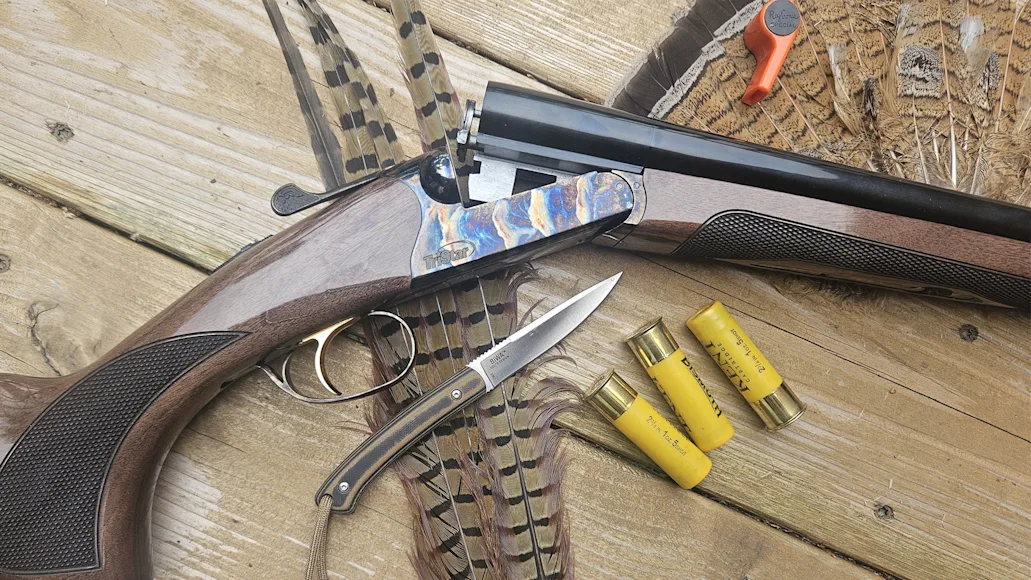_We may earn revenue from the products available on this page and participate in affiliate programs. Learn more ›
_
With side-by-side shotguns making a small comeback among upland hunters, the new Phoenix from Tristar adds a very affordable option to the side-by-side double market. The Kansas City-based company keeps building on a reputation for inexpensive, reliable shooters backed by excellent customer service, and the Phoenix fits perfectly into their lineup. Tristar already had a side-by-side, the Bristol, and the Phoenix is basically a budget Bristol, with extractors in place of ejectors and priced $400 lower. I recently got a chance to put a new 20-gauge Phoenix through the wringer at home and at my local range. Here is my full review.
Tristar Phoenix Side-by-Side Specs
Length: 45 inches
Weight: 6.75 pounds (20-gauge)
Barrel: 28-inch concave rib, brass bead, 5 extended chokes
Action: Break-action side by side
Trigger: 7 pounds
Capacity: 2
Finish: Case colored receiver
Stock: Gloss walnut
Chambering: 3-inch 12-gauge, 3-inch 20-gauge (tested)
Price: $795
Tristar Phoenix Side-By-Side Overview

The fit and finish of the new Phoenix is quite nice for the price.
Made by Kral in Turkey, the Phoenix is available in 12- and 20-gauge, both with 3-inch, chrome-lined chambers and barrels that can handle steel shot. Each comes with five Beretta-style, flush-mounted choke tubes. Instead of the Bristol’s oil finish, the Phoenix has a gloss urethane coat on its forend and pistol-gripped stock. It shares the Bristol’s single selective trigger and features a Beretta-style safety/barrel selector with a tab you slide back and forth to choose between left and right. The frame is case-colored, including the trigger guard, lever, and Deeley forend latch.
Fit and finish-wise, the gun is a mixed bag, but remember, we’re looking at an $800 double gun. The wood is nice, with good color and a bit of grain, and the finish has none of the globs nor drips you’ll see on some guns. While I usually prefer oil finishes, this gun’s wood and finish grew on me. I didn’t like the angled tip of the forend. I’d have preferred something rounded, but the angled tip does give you a convenient finger-hold when you need to remove it. The barrels are finished to a handsome gloss black, although there’s a dull spot on my gun around the lettering stamped on the breech. There are some visible tool-marks here and there, as well. None of these flaws are deal-breakers on a budget gun made to be used in the field, because you have to give up something to keep the price down.
My 20-gauge test gun weighed 6 ¾ pounds with 28-inch barrels, which is a little heavy for an upland 20, but not too heavy, and a great heft for doves and waterfowl. The trigger breaks cleanly at about 7 pounds, which is good compared to many Turkish doubles I’ve shot.
**Related: The Best Budget Shoguns of 2024
**
Tristar Phoenix Range Review and Test Results

The author shoots a round of skeet while testing the new Tristar Phoenix. Phil Bourjaily
At the range, I found it to be flat-shooting and easy to hit skeet targets with. The stock has a lot of drop to it, more than you’ll find on many side-by-sides, although not so much as the old American guns. Those dimensions gave me a view flat down the barrels. The gun does have a traditional concave rib, which is designed not to be seen, and a brass bead. If you keep your eyes on the target, as you should, a concave rib works well. I liked it. If you want a rib to sight down, though, you won’t find one on this gun. The recoil pad is thin, but fairly soft, and it has a hard rubber insert on top to keep it from grabbing your clothes as you raise the gun. That’s a nice touch.
The mechanical trigger always worked, the extractors lifted fired and unfired shells. The chokes tubes spun in and out smoothly, and the forend latch was easy to use. Only the barrel selector on the safety was a problem on my test gun. The manual safety itself felt gritty when I pushed it, and it was too easy to bump the barrel selector so it rested between left and right, resulting in a safety that wouldn’t push forward sometimes. It may just have been a problem with my test gun, but if this were my gun, I’d want the selector fixed, and I doubt it would be a difficult problem to repair.
Final Thoughts on the New Tristar Phoenix
Pros:
Excellent value
Good wood and finish for the price
Cons:
On the heavy side
Barrel selector on test gun gave me minor problems
Of course there are much nicer side-by-sides out there if you’re willing to spend a couple grand or more. But it’s important to have some solid, reliable double guns that most anyone can afford—and the Tristar’s latest is a solid example. The selector problem aside, the Phoenix seems like a good gun for the money, especially if you want a side-by-side with a single trigger in place of the traditional double triggers.
**Read Next: The Best Shotguns of 2023
**


